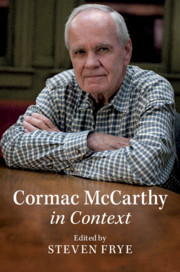Book contents
- Cormac McCarthy in Context
- Cormac McCarthy in Context
- Copyright page
- Contents
- Contributors
- Acknowledgments
- Chronology
- Part I Environments
- Part II Literary Contexts: Sources, Influences, Allusions
- Part III Intellectual Contexts
- Chapter 12 The Judeo-Christian Tradition
- Chapter 13 Gnosticism
- Chapter 14 Classical and Pre-Classical Philosophy
- Chapter 15 Nineteenth- and Twentieth-Century Philosophy
- Chapter 16 Formal Aesthetic Choices
- Chapter 17 Science and Technology
- Part IV Social and Cultural Contexts
- Part V Archives, Critical History, Translation
- Works Cited
- Index
Chapter 17 - Science and Technology
from Part III - Intellectual Contexts
Published online by Cambridge University Press: 12 December 2019
- Cormac McCarthy in Context
- Cormac McCarthy in Context
- Copyright page
- Contents
- Contributors
- Acknowledgments
- Chronology
- Part I Environments
- Part II Literary Contexts: Sources, Influences, Allusions
- Part III Intellectual Contexts
- Chapter 12 The Judeo-Christian Tradition
- Chapter 13 Gnosticism
- Chapter 14 Classical and Pre-Classical Philosophy
- Chapter 15 Nineteenth- and Twentieth-Century Philosophy
- Chapter 16 Formal Aesthetic Choices
- Chapter 17 Science and Technology
- Part IV Social and Cultural Contexts
- Part V Archives, Critical History, Translation
- Works Cited
- Index
Summary
Cormac McCarthy’s interest in science and association with the interdisciplinary Santa Fe Institute is well remarked. Scholars less regularly explore how scientific theories inform his work, with critics more often noting his generally negative figuration of advanced technologies. On April 20, 2107, after decades of publishing only fiction, plays, and screenplays, McCarthy contributed an essay on linguistics, dream, and the unconscious to the online science journal Nautilus. “The Kekule Problem” occasioned notable critical reactions online, with McCarthy responding in a second essay. This chapter considers these essays while providing an overview of the influence of science and technology on his creative work. McCarthy’s interest in scientific theories promises rich territory for future scholarship, particularly to complement attention to dreams and to figurations of technology. Ultimately, McCarthy’s speculation on lingusitics proves less valuable to that field, of course, than as insights into his own writing process. Open scientific inquiry and speculation run alongside the power of dreams and tecnological skepticism throughout his creative work.
Keywords
- Type
- Chapter
- Information
- Cormac McCarthy in Context , pp. 180 - 194Publisher: Cambridge University PressPrint publication year: 2020
- 1
- Cited by



